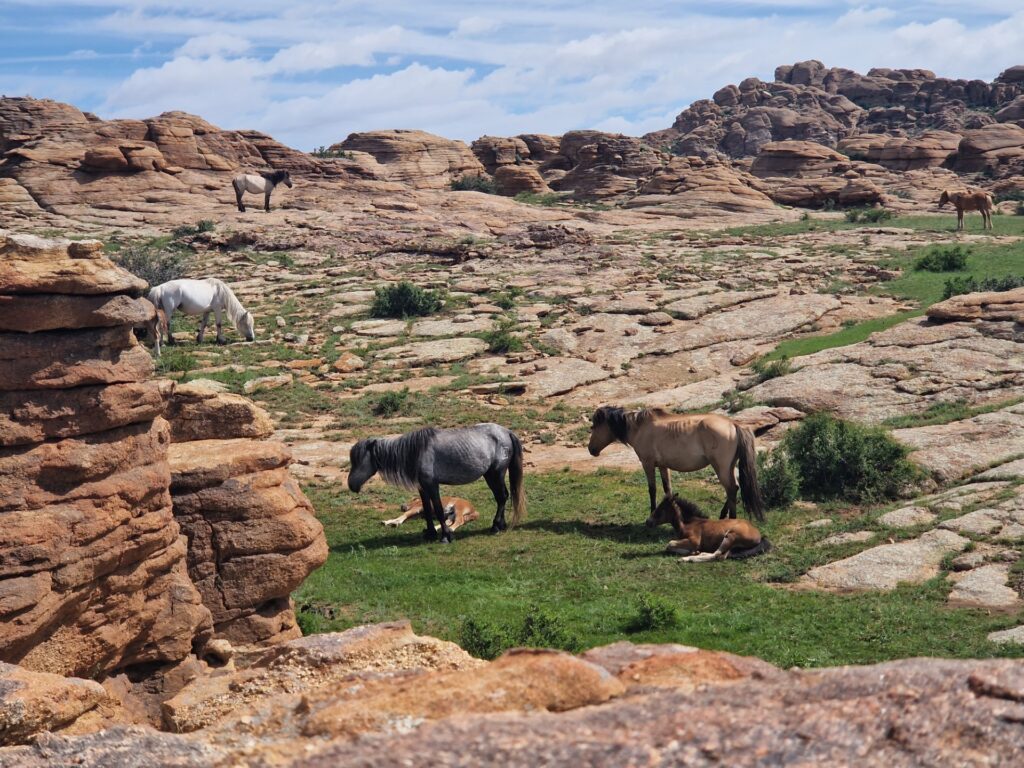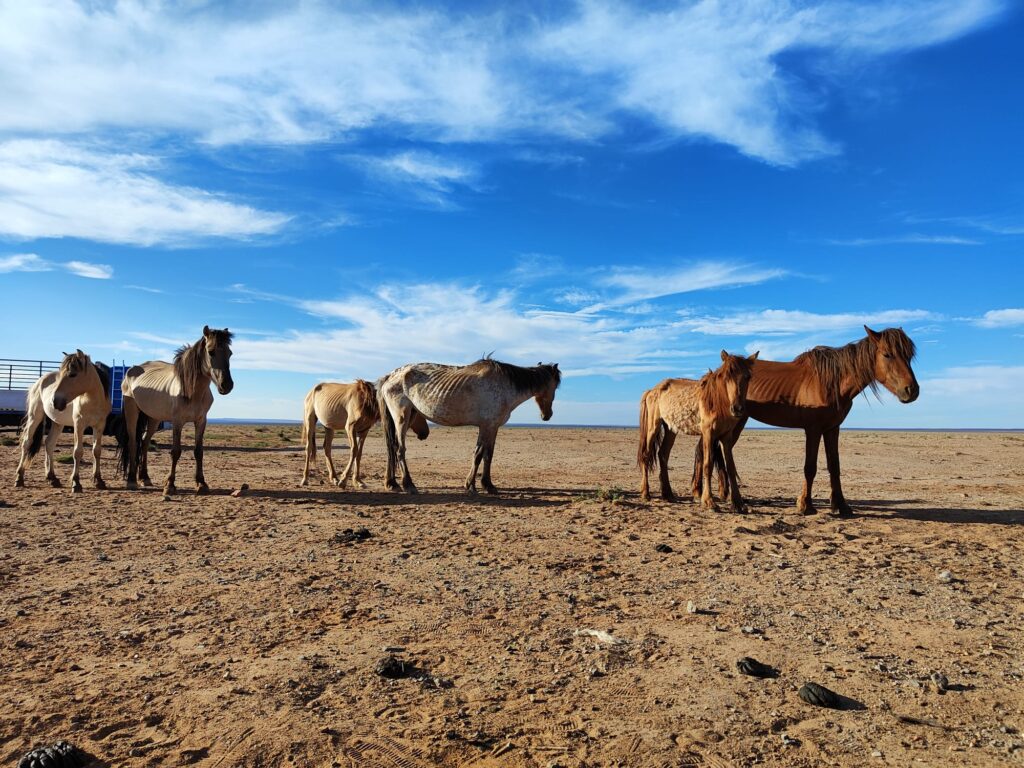I have lived and worked in deserts in Arabia for decades. First in the arid and semi-arid steppe land of Syria and Jordan and then in Oman on the edge of the Empty Quarter. I have worked with sheep and goat herders in the north of Arabia and with camel (one humped dromedaries) and goat herders in the south of Arabia. So, I thought I knew what to expect when invited to Mongolia and the promise of a trip to visit the herders in the centre of the Gobi Desert. What I did not expect was to see so many of my assumptions – many based on empirical findings – turned upside down.
Over three days in the summer of 2023 I visited three herder households in the Gobi desert, and instead of finding hot and arid land of gravel and sand, sand dunes and little if any vegetation, I found a verdant landscape rich green as far as the eye could see, clouds billowing above a dense, blue sky, and large herds of horses, sheep and goat, camels, and cows grazing in every direction. Temperatures at the end of June were moderate ranging between 20 – 25 C. in the daytime and dropping to between 5-10 C. at night. How could this be a desert when it looked like a gorgeous late spring or summer day in much of the United Kingdom and northern Europe? Certainly, the problem was of my making. Had I read up about the Gobi Desert, I would have learned that the high altitude Gobi Desert (average between 1200 and 1500 meters) is technically a cold desert and grassland, with winter temperatures sometimes as low as -40 F ( -40 C) and summer temperatures possibly as high as 122 F ( 50 C).

Seeing immense herds of horses, cows, sheep and goat, and camels seemingly free to roam with little sign of any human herders, was my first surprise. I wondered how they were managed or brought back into the herders’ homesteads at night. Our first stop was a herder family still in their winter campsite with protective stone walls for keeping their herds safe from fierce winds and freezing temperatures in the cold season. A Ger had been set up for our visit – part of the family was living in a cabin on wheels adjacent to the Ger – and at a short distance, another Ger housed the parents of the male household head. Our hosts had one teenage son, but male cousins of about the same age were also present. Four recently shaved camel (with only tufts of hair on their head remaining so that they did not look too ugly, our hostess told us) were tied up near the Ger close to the protective animal sheltering stone wall. On the other side of the wall, we found a mare and her day-old foal; its failure to stand up immediately after its birth or the mare’s seeming rejection of it resulted in the two of them being kept in the enclosure for 48 hours. Once the herder was satisfied that the two had bonded, they were released – good husbandry!
We were invited to the Ger where we found a huge rock suspended by rope from the central circular crown in order to hold the structure down in high winds. A table behind it was ladened with food, mainly white food – a good omen in Buddhism – dried milk curds of various kinds and shapes from cow, sheep, and goat. Mare’s milk was usually fermented into a potent drink and offered to guests, but instead of that I saw a bottle of vodka and another of whiskey. I now felt the familiarity of the hospitality of herders in any kind of desert. In Arabia it would be dates and coffee essence, followed by milky tea. Here in the Gobi dried milk curd was later followed by vodka, and towards the end of the evening whiskey. I asked our hostess where the family’s herds were, and she explained that in summer they are all released to graze on the rich pastures around them. In winter they were kept closer to the household and sheltered within enclosures at night. In summer with all the animals released to graze freely, the mares were generally managed and moved ‘en masse‘ by their stallion, but the sheep and goat, camels, and cattle were lightly managed by the males of the household using motorcycles to keep an eye on them and to make sure they did not move too far away. In the past that would have been on horseback. Unlike the deserts of Arabia where the goats and sheep as well as camels returned in the evening to have additional fodder – generally third grade wheat chaffs – these herds generally remained out in the rich pasture lands until the end of the summer when the hard work of rounding them all up commenced. All hands were needed to bring in the family’s herds, and often communication with relatives and friends helped to locate animals that had moved farther afield. This household was an extended three generational one and the added labour of nephews was important in managing their animals. The fact that it did not move from its winter campsite or residence made me wonder whether that needed some kind of negotiation with other households who might have expected to move into this location over the short summer months of rich grasses, commonly grey sparrow’s saltwort, grey sagebrush, needle grass, and bridle grass. During the nearly 70 years that Mongolia was part of the Soviet Union herders were organized into cooperatives. These were meant to replace an older system based on an aristocracy and inferior herder ‘families.’ Once the Soviet Union collapsed and Mongolia became independent, international agencies rushed into the country to organize herders into ‘user groups’ as though there was no underlying system that might have survived the Soviet era. My own experience in Syria told me that despite the socialist efforts of the Syrian state to undermine tribal lineages by organising people and territory into state-run cooperatives, still tribal lineages, leaderships, and association to tribal common land remained under the radar. I wondered if something similar had happened, or was happening in Mongolia?
Our second household answered some of these questions. After driving for several hours and passing by hundreds of horses, some quietly grazing other thundering away under the masterful steer of its stallion, we came to a household with two cabins on wheels, solar panels, and an assortment of vehicles, and motorcycles. But there was no traditional felt Ger. We were greeted b the household head – a grandmother and her niece and grandchild. We were seated in a caravan of mod cons – freezer, refrigerator, cabinets neatly storing cooking utensils, mobile phones, and other paraphernalia of modern herders. And as before were were offered extraordinary generosity, meat-based broth, fried dough balls, and other delicacies of the regional cuisine. We asked why there was no Ger set up and we were told that they had moved recently hundreds of miles across the Gobi for the summer grazing. They had, by our host’s estimate, 2,000 head of horses, 1,000 goat and sheep, hundreds of cattle and camels. So large was her herd of horses, that she told us she had to be careful to negotiate the location of her summer camps with kin and ‘friends.’ Friends, we understood were, people with whom she had created a relationship – she gave them gifts, generally of the fermented mare’s milk which she made in abundance, and they returned the gift with an offering as well as welcome to bring her herds to their region. Friends sounded like a more accurate way of understanding how herders determined their kinship and support groups to manage the Gobi grasslands in summer than the international expert imposition of ‘user group.’ At least ‘friends’ was intimately descriptive and analytically more promising than the term introduced by outsiders in the early 1990s (and continues to be used by some international agencies). This household or extended family group was particularly revealing to me as it was a kin group at the height of its family development cycle. Our hostess told us that she had three grown children who had all attended university and had decided to remain herders. So, in effect these large herds belonged to four nuclear families still moving and managing their herds together. At some point they will split up, but probably maintain good relations and coordinate their movements from one grazing area to another. She told us how in winter she would go to the provincial capital with her children so that they would attend boarding school, and in summer some of the grown men would go off and get jobs in construction. So not only the herds were mobile, but the family members too. In Arabia, it was only the grown men who would go off to take jobs with the police, the army, or the security services to maintain and service the four-wheel drive vehicles they depended on for animal husbandry and general mobility.
Before leaving we asked again about her huge summer movements across the Gobi and whether she had always moved so far and wide. It was climate change that was making these long migrations necessary she told us. Pastures that could support her massive horse herds were few and far between and her ‘friends’ could communicate with her by mobile phone to inform her of good places to bring her herds. Climate change rather than the development experts’ finger pointing at ‘degradation’ was the issue as far as she was concerned. There was good pasture and there was inferior pasture, and this was dependent upon the changing patterns of rainfall (averaging about 150 cm per year) and increasing temperatures.

Our last stop was at a household with a Ger and a cabin as well as several cows and their newborn offspring tied up nearby and two very young foals by the entrance to the Ger. I remember thinking to myself how unusual to see two probably orphaned animals. In Arabia, the herders used to say one orphaned animal was bad luck, two was bad husbandry, and three was a disaster. As we entered the Ger I was already wondering how successful a herder this household head was. Our hostess was cooking another traditional Mongolian dish dried meat (from the winter supply) and noodles over a large cooking pot and stove fuelled by camel dung. A niece and a grandchild were present and seemed to enjoy the novelty of our company. We asked more questions about the herds and herders and how decisions were taken about when and where to move. In the distance was a herd of horses which was being managed by a son on motorcycle to keep it relatively close to the household. They had to keep an eye on them, we were told, to make sure they did not wander too far off. And yes, the two foals were about a month old, their mothers had died. They would grow up to be very comfortable around humans as they were being bottle fed by the children of the household.
Not far from this household we came across their herd of sheep and goat in a corral, being sheared for the summer. The inner coat of the goats had already been combined out to sale for cashmere. In the past the wool from the sheep would have had some value too , but today, it was discarded, along with the camel hair. The winter’s heavy fleeces, all needed to be removed for the summer months in the Gobi. What could be sold was, and the rest was discarded. I asked at what age were the males culled – sold for meat – from the herd. In Arabia, that was generally between 3-4 months for goat, and about 5-6 months or more for camels. No, in the Gobi, males were castrated and kept with the herds. Camels were castrated before they were four years old and the other animals before they reached full maturity. They were not eaten by the families, but sometimes they were sold for meat. In the Soviet times, the castrated horses were sent to Russia. But now there was no clear foreign market, so castrated males were sold locally. This emphasis on castration rather than culling was how the herds can reach such large sizes. In Arabia the herds are mainly ‘nanny’ herds. That is, it is their milk, from goat and camels, that is so highly prized and young male animals are culled and sold off early to lessen the ‘non-productive’ elements of a herd. But in the Gobi, it is the fermented mare’s milk that brings in significant income, along with the sale of castrated animals. As our second household visit revealed, the sale of fermented mare’s milk (and some castrated horses) could put three children through school and university education! Herding in the Gobi might be an alternative lifestyle to modern urban capitalism, but it can be highly successful as long as climate change is recognized and addressed appropriately. To blame the change in the grazing lands of the Gobi on the huge increase in numbers of herds and the ‘inevitable’ land degradation that follows – without any empirical evidence – is to follow the assumptions imported into the country by foreign development experts. Change is happening, but climate change needs to be recognized as a significant factor. It is a universal problem as well as a reginal one in the Gobi desert.

No responses yet